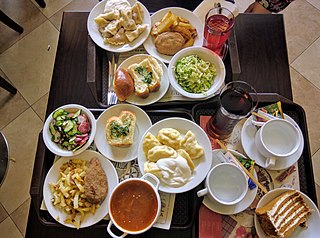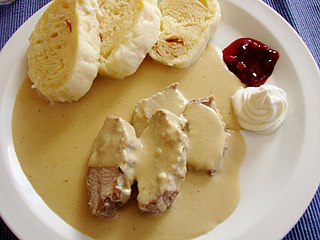
Baking is a method of preparing food that uses dry heat, typically in an oven, but can also be done in hot ashes, or on hot stones. The most common baked item is bread, but many other types of foods can be baked. Heat is gradually transferred "from the surface of cakes, cookies, and pieces of bread to their center, typically conducted at elevated temperatures surpassing 300°F. Dry heat cooking imparts a distinctive richness to foods through the processes of caramelization and surface browning. As heat travels through, it transforms batters and doughs into baked goods and more with a firm dry crust and a softer center. Baking can be combined with grilling to produce a hybrid barbecue variant by using both methods simultaneously, or one after the other. Baking is related to barbecuing because the concept of the masonry oven is similar to that of a smoke pit.

Flour is a powder made by grinding raw grains, roots, beans, nuts, or seeds. Flours are used to make many different foods. Cereal flour, particularly wheat flour, is the main ingredient of bread, which is a staple food for many cultures. Corn flour has been important in Mesoamerican cuisine since ancient times and remains a staple in the Americas. Rye flour is a constituent of bread in both Central Europe and Northern Europe.

Cornbread is a quick bread made with cornmeal, associated with the cuisine of the Southern United States, with origins in Native American cuisine. It is an example of batter bread. Dumplings and pancakes made with finely ground cornmeal are staple foods of the Hopi people in Arizona. The Hidatsa people of the Upper Midwest call baked cornbread naktsi. Cherokee and Seneca tribes enrich the basic batter, adding chestnuts, sunflower seeds, apples, or berries, and sometimes combine it with beans or potatoes. Modern versions of cornbread are usually leavened by baking powder.

Roti is a round flatbread originating from the Indian subcontinent. It is commonly consumed in many South Asian, Southeast Asian, Caribbean, and Southeast African countries.

Ukrainian cuisine is the collection of the various cooking traditions of the people of Ukraine, one of the largest and most populous European countries. It is heavily influenced by the rich dark soil from which its ingredients come, and often involves many components. Traditional Ukrainian dishes often experience a complex heating process – "at first they are fried or boiled, and then stewed or baked. This is the most distinctive feature of Ukrainian cuisine".

Jewish cuisine refers to the worldwide cooking traditions of the Jewish people. During its evolution over the course of many centuries, it has been shaped by Jewish dietary laws (kashrut), Jewish festivals and holidays, and traditions centred around Shabbat. Jewish cuisine is influenced by the economics, agriculture, and culinary traditions of the many countries where Jewish communities have settled and varies widely throughout the entire world.

Pennsylvania Dutch cuisine is the typical and traditional fare of the Pennsylvania Dutch.
Latvian cuisine typically consists of agricultural products, with meat featuring in most main dishes. Fish is commonly consumed due to Latvia's location on the eastern shore of the Baltic Sea.

Potato bread is a form of bread in which potato flour or potato replaces a portion of the regular wheat flour. It is cooked in a variety of ways, including baking it on a hot griddle or pan, or in an oven. It may be leavened or unleavened, and may have a variety of other ingredients baked into it. The ratio of potato to wheat flour varies significantly from recipe to recipe, with some recipes having a majority of potato, and others having a majority of wheat flour. Some recipes call for mashed potatoes, with others calling for dehydrated potato flakes. It is available as a commercial product in many countries, with similar variations in ingredients, cooking methods, and other variables.

Czech cuisine has both influenced and been influenced by the cuisines of surrounding countries and nations. Many of the cakes and pastries that are popular in Central Europe originated within the Czech lands. Contemporary Czech cuisine is more meat-based than in previous periods; the current abundance of farmable meat has enriched its presence in regional cuisine. Traditionally, meat has been reserved for once-weekly consumption, typically on weekends.

Steamed bread is a kind of bread, typically made from wheat, that is prepared by steaming instead of baking. Steamed bread is produced and consumed all around the world. In Chinese cuisine, mantou is a staple food of northern China, where up to 70% of flour production in the region is used to make it. There are now many variations of mantou in China, for example wholemeal mantou, milk mantou, and sweet potato mantou. Wotou is another steamed bread found in northern China. In South African cuisine, a number of groups produce steamed bread, such as the Zulu ujeqe which can be eaten alone or with tomato soup. South African steamed breads are typically made at home for consumption on the same day, but research on commercial production continues to advance, aided by earlier developments in the mass production of Chinese steamed bread. In the cuisine of the United States, one example of steamed bread is Boston brown bread.

A teacake in England is generally a light yeast-based sweet bun containing dried fruit, typically served toasted and buttered. In the U.S. teacakes can be cookies or small cakes. In Sweden, they are soft, round, flat wheat breads made with milk and a little sugar, and used to make buttered ham or cheese sandwiches. In India and Australia, a teacake is more like a butter cake. Tea refers to the popular beverage to which these baked goods are an accompaniment.

Levantine cuisine is the traditional cuisine of the Levant, in the sense of the rough area of former Ottoman Syria. The cuisine has similarities with Egyptian cuisine, North African cuisine and Ottoman cuisine. It is particularly known for its meze spreads of hot and cold dishes, most notably among them ful medames, hummus, tabbouleh and baba ghanoush, accompanied by bread.

Indian breads are a wide variety of flatbreads and crêpes which are an integral part of Indian cuisine. Their variation reflects the diversity of Indian culture and food habits.

Tatar cuisine is primarily the cuisine of the Volga Tatars, who live in Tatarstan, Russia, and surrounding areas.

Bread is a staple food of Finland. It is served with almost every meal and many different types are produced domestically.

Silesian cuisine belongs to the region of Silesia in Central Europe. It is a subtype of Polish and German cuisine with many similarities to and signs of the influence of neighbouring cuisines. The cuisine is particularly renowned for its poppy seed and knödel dishes.

Podpłomyk, known in Old Polish as wychopień or wychopieniek, is the oldest known Slavic form of bread, in the form of a small flatbread baked on an open fire. It has been preserved to the modern day as a part of Polish cuisine.
Romani cuisine is the cuisine of the ethnic Romani people. There is no specific "Roma cuisine"; it varies and is culinarily influenced by the respective countries where they have often lived for centuries. Hence, it is influenced by European cuisine even though the Romani people originated from the Indian subcontinent. Their cookery incorporates Indian and South Asian influences, but is also very similar to Hungarian cuisine. The many cultures that the Roma contacted are reflected in their cooking, resulting in many different cuisines. Some of these cultures are Middle European, Germany, Great Britain, and Spain. The cuisine of Muslim Romani people is also influenced by Balkan cuisine and Turkish cuisine. Many Roma do not eat food prepared by a non-Roma.
Bread in American cuisine are a range of leavened and flatbreads made with various techniques that have been a staple of American cuisine since at least the time of the Thirteen Colonies.




















